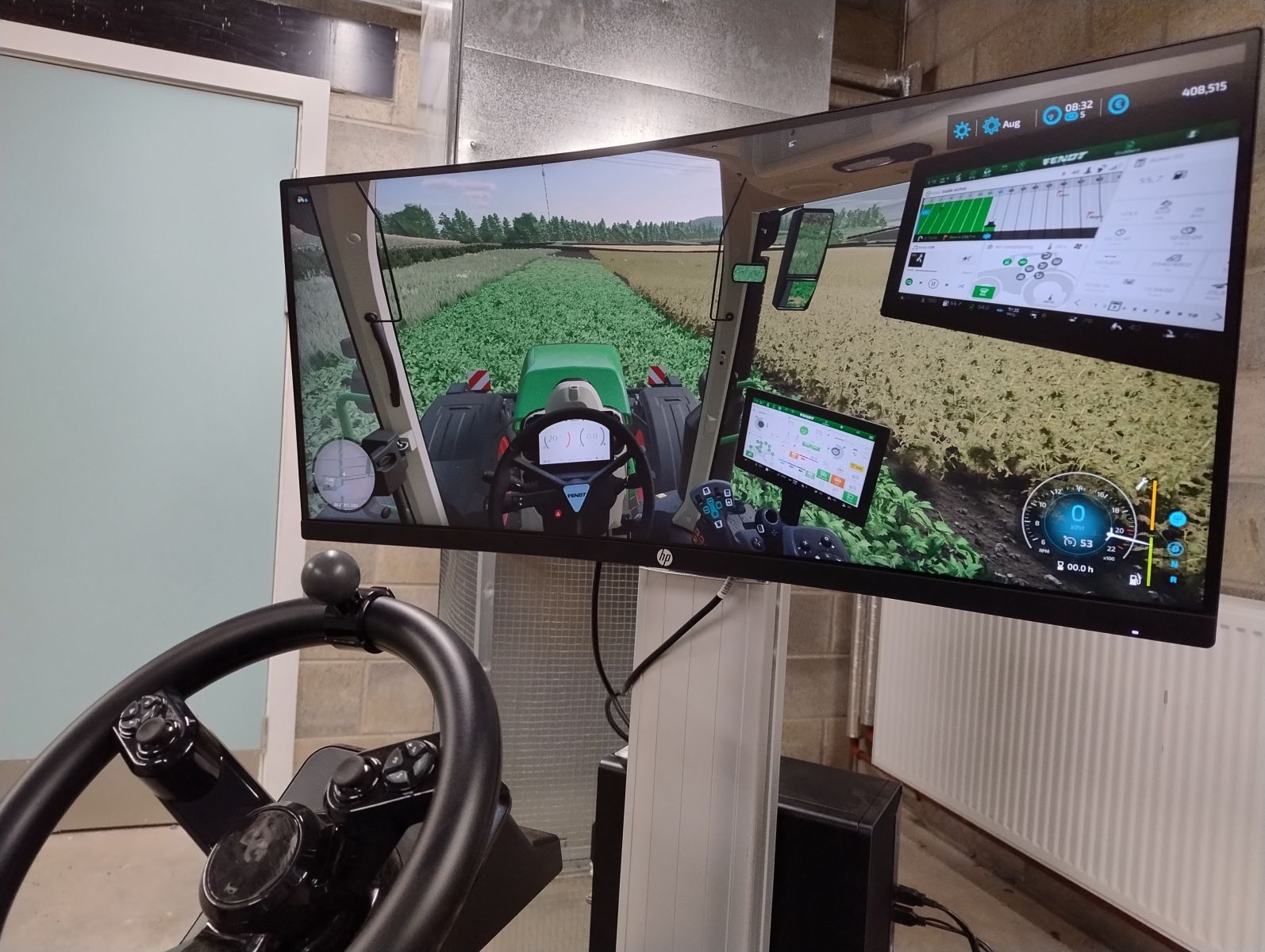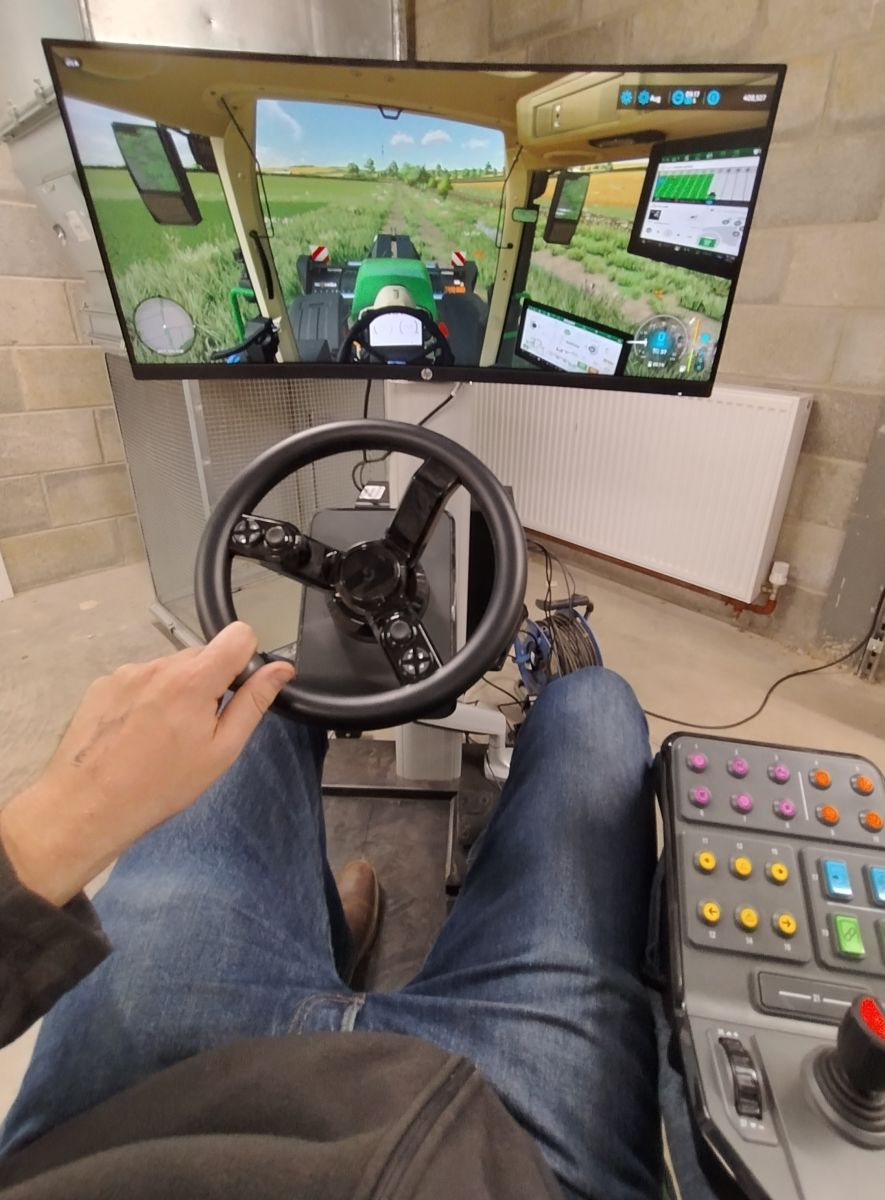What is CROPsim?
Agricultural research is important in helping to address global challenges, from sustainable food production to biodiversity. Despite its importance, it can often be seen as complex and thereby inaccessible. To address this challenge, the researchers behind the CROPsim project asked; what if people could try being a farmer virtually, seeing and experiencing the results of different farming practices, instead of just reading about sustainable farming? Thus, at its core, CROPsim translates complex research findings into interactive experiences that anyone can enjoy.
To do this, CROPsim uses the popular Farming Simulator platform (a farming simulation video game) where players can grow crops, breed livestock and other activities related to agriculture. The game has sold over 25 million copies worldwide and 92% of the reviews are favorable. As a ready-made software platform, the project team, led by Andrew Christie, decided to use it to create a virtual twin of the James Hutton Institute's Balruddery Farm. Balruddery Farm is a 170-hectare arable research farm, located on the Sidlaw hills, five miles west of Dundee. The main outputs of the farm are integrated crop systems, which improve soil biophysical quality, enhanced biodiversity and system function with minimal impact on crop yields. The farm is also home to events such as Arable Scotland and Potatoes in Practice.
By using gaming as a tool, the project is aiming to reach new audiences and encourage them to engage with science and its application, in very hands-on way. In particular, by creating a virtual twin of one of a research farm, the game allows users from farmers to policy makers, students, and the general public to understand how research farming is done, participate in research-related activities, and explore ideas of sustainable agriculture, all by having a go themselves. The simulator essentially enables players to participate farming activities whilst showing the research that can inform those activities.
How does CROPsim work?
The project team (researchers from James Hutton Institute, Scotland’s Rural College, Biomathematics and Statistics Scotland, the Centre for Sustainable Cropping, the Plant Health Centre and ClimateXChange) used the open-access GIANTS editor tool within Farming Simulator to create a modified game environment, or ‘mod map’ (a custom version of the game’s map made by users or developers), based on the Centre for Sustainable Cropping at Balruddery Farm. The custom “mod map” brings 14 years of SEFARI’s interdisciplinary research to life, showing work across areas like crop breeding, agronomy, soils, biodiversity, hydrology, and agroecology.
The game’s framework also allows detailed customization, so CROPsim can simulate specific soil types and crop systems. These customizations allow players to experience diverse Scottish farming practices, from integrated pest management (IPM) to visual representation of landscape management such as riparian buffer strips (sections of vegetation alongside a river that provides environmental benefits). In addition, players can simulate driving a tractor in a real-world field in a module that has a steering wheel, pedals and other controls made up of units, just like a real tractor cab!

View from inside cab in-game (Credit: project team)
While navigating around the virtual farm, you can collect aphid traps, spray weeds, and harvest barley. All of these tasks are created based on research; therefore, the player receives key messages regarding pest management, soil health, and the environmental impact of farming practices. For example, when you successfully collect an aphid trap, you don’t just perform a task, you are guided through the science of pest monitoring, with pop-up messages explaining what you are doing and why it matters.
Example pop-up message from a successful activity, this is after collecting an aphid trap (Credit: project team)
CROPsim also encompasses methods of decision-making in the game that are similar to those found on real farms. The player is given the opportunity to utilize precision farming techniques in matters such as soil mapping and nutrient management to optimize the crop yields. Such an approach makes CROPsim a really useful education tool, and is a great addition to the other educational materials we have available.
Beyond knowledge exchange, CROPsim has the potential to facilitate inspire new research collaborations within SEFARI and externally. This kind of shared virtual environment that showcases interdisciplinary research (similar to our other virtual tool projects e.g., SEFARI Tour of Scotland’s Climate Research and SEFARI Farm Tours) are really useful platforms in widening the accessibility of research.
What do people think about CROPsim?
So far, the CROPsim project team have tested the game at Arable Scotland in July 2024. The event was had around 300 attendees (check out Arable Scotland Blog), providing a high-profile opportunity to present CROPsim and get feedback from the delegates. The game also received a media attention, featuring on STV. Collum Clark, from STV News at Six, noted “the simulator let these people find out more about various farming practices, they don’t have to actually be there”.
From those that have tried the game, the most positive feedback seems to come from the aphid yellow water trap activity, where the player has to collect the traps and each time they do, a popup message appears with a bitesize piece of information. When completed in sequence this activity forms the full story of SEFARI research and helps to explain the educational value of the game. The users found this delivery of information catchy and very straightforward.
At the same time, the project team also found out that they could improve the physical experience of the simulator unit. By bracing the steering wheel and strengthening the floor of the unit to reduce wobble, any person using the facility in the future will find it easier and more immersive to do so.

Action shot from testing (Credit: project team)
What next for CROPsim?
Looking forward, CROPsim has a wealth of potential for growth and expansion. The positive responses, from Arable Scotland attendees and interest from collaborators, highlight how the project could evolve into a long-term knowledge exchange platform.
One of the next steps for the team is to publish the CROPsim map on the official Farming Simulator mod hub, making it accessible to the game’s global community of users. This move would allow CROPsim to reach beyond Scotland, sharing SEFARI’s research with players worldwide and significantly extending the project’s impact.
Additionally, the team are developing the map by adding detail to the rest of the research farm and surrounding areas. By expanding the game, CROPsim could be used to communicate an even broader array of research findings, helping players learn about the diversity of agriculture and the importance of sustainability.
Finally, collaboration is also a key element of CROPsim’s future. The project team have been approached by several external stakeholders, such as LEAF and AHDB. These collaborations provide a route to an expanded platform and further increase CROPsim’s educational value.
CROPsim is transforming how we share agricultural research by making it accessible, interactive, and fun. This immersive approach helps people connect with sustainable farming practices in a hands-on way. It will be exciting to see how CROPsim continues to develop, reaching even more audiences and sparking new interest in sustainable agriculture.
Project team: Andrew Christie, Ali Karley, Cathy Hawes, Craig Bothwell, Damian Bienkowski, Katherine Preedy and Sarah Govan.
Dawei Cai has helped with the writing of this blog. He has been on work placement with SEFARI Gateway and is pursuing his MSc in Science Communication and Public Engagement at University of Edinburgh.

